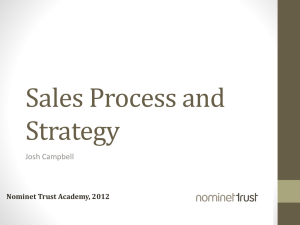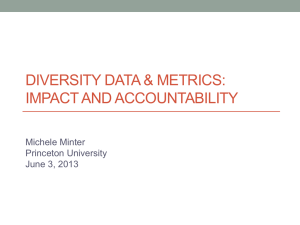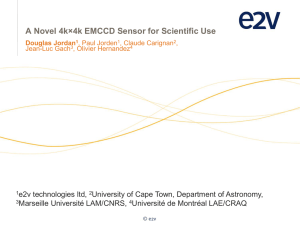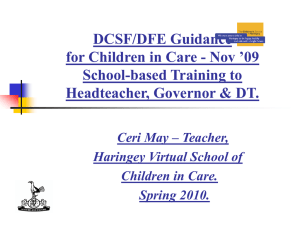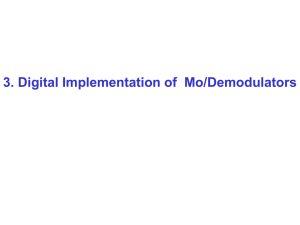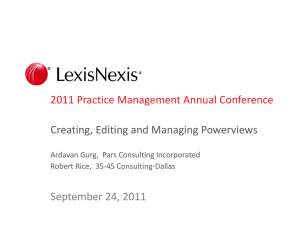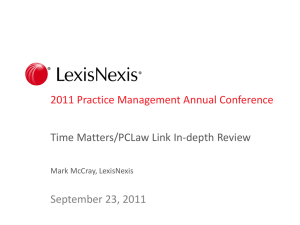UMETRICS Presentation (Weinberg)
advertisement
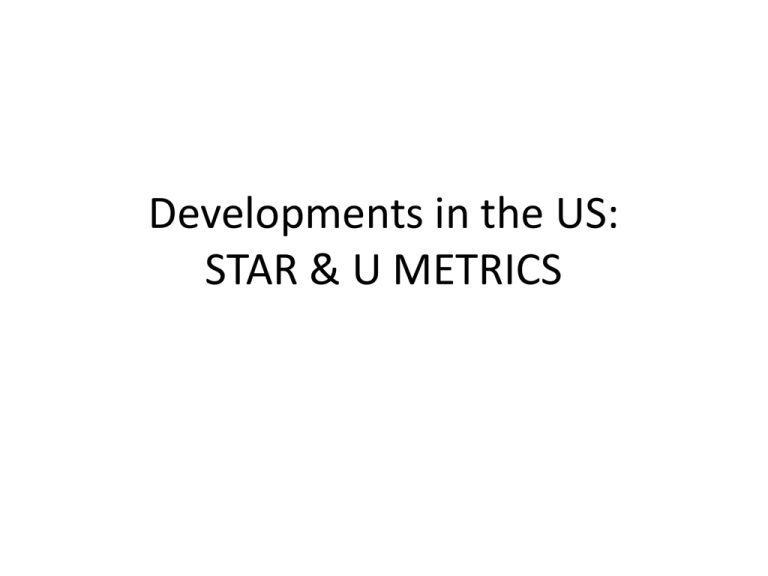
Developments in the US: STAR & U METRICS Motivation The President recently asked his Cabinet to carry out an aggressive management agenda for his second term that delivers a smarter, more innovative, and more accountable government for citizens. An important component of that effort is strengthening agencies' abilities to continually improve program performance by applying existing evidence about what works, generating new knowledge, and using experimentation and innovation to test new approaches to program delivery. STAR METRICS • National program: White House led interagency initiative, now housed at NIH • Broad participation: >100 research orgs (45% of NSF/NIH funding) • Unique data: Project level data on internal financial and HR data on expenditures from federal grants • Low burden / cost: uses algorithms & existing data • Theoretically grounded: Builds on microfoundations Conceptual Framework Empirical Framework • Level 1: Document science inputs: the workforce and equipment expenditures supported by federal funding • Level 2: Develop an open automated data infrastructure and tools that will enable us to document and analyze the inputs, outputs, and outcomes resulting from federal investments in science U METRICS • Private initiative to use STAR METRICS data from 15 major research universities that comprise the Committee on Institutional Cooperation (CIC) to analyze: 1. Impact of Science 2. Structure of research workforce 3. Optimize research Products • • • • Templated, scalable reports Integrated dashboard Open source data infrastructure Sandbox for research to develop tools • • • • • • • • • • • • • • • University of Chicago University of Illinois Indiana University University of Iowa University of Maryland University of Michigan Michigan State University University of Minnesota University of Nebraska-Lincoln Northwestern University Ohio State University Pennsylvania State University Purdue University Rutgers University University of Wisconsin-Madison The CIC The CIC • Most of the leading research universities in the Midwest United States • $9.3B in research • “Shanghai” ARWU range from #8 (U Chicago) to 68; median ranking is 35 U METRICS Projects • Impact, NSF Funded – Analyze distribution, geographic location, and industry of vendors – Analyses the collaborative networks supported by research funding – Offers the first comprehensive picture of the effects of federal R&D on economic resilience and job creation • Training (Discuss tomorrow), NSF Funded • Food Security, US Dept. of Agriculture proposal – Impact from federally funded research targeted at the agricultural sector in general and food safety in particular • Communication, NSF proposal – How new comp sci, data, and tools can inform policymakers’ attitudes, decisions, and understanding of WHAT science research is funded and with what RESULTS • Innovation and Aging, National Institute on Aging proposal – Understand impact and responses to aging innovative workforce – Build data infrastructure to support research CIC Activity: Economic Impacts Zoom Out Analysis of: Entire scientific enterprise Useful for: Government and institutions to justify and set level of science investments Econometric analysis Method: Status: In progress Zoom In Scientific fields Entire research institutions and funders Government Institutions to justify and and funders allocate to document investments performance to fields Econometric Bibliometric, Text, + analysis Econometric In progress Planned Specific fields Specific labs, at specific researchers institutions Identify bestpractices, target investments Bibliometric, Text, + Econometric Planned Micro-benchmark performance, identify underexploited opportunities Bibliometric, Text, + Econometric Planned Training Environments Project • Funded by National Science Foundation • Uses CIC STAR METRICS LEVEL I data • Researchers from OSU, Iowa, Illinois, Penn State, Chicago and AIR • Examines the impact of different research funding structures on the training of future scientists, particularly graduate students and postdoctoral fellows, and the impact on their subsequent outcomes. • Link the data to universe data on student jobs, earnings and industries • Uses computer science technologies that permit the capture of information from text documents – to describe what research the students are being trained in Building a Social Science Research Community around a new R&D Data Infrastructure • Funded by National Science Foundation • Uses CIC STAR METRICS Level 1 Data • Researchers Jason Owen Smith and Maggie Levenstein, University of Michigan • Analyses the distribution, geographic location, and industry of vendors that supply federally funded research, • Analyses the collaborative networks supported by research funding • Offers the first comprehensive picture of the effects of federal R&D spending on economic resilience and job creation via companies that support university research. Proposed study on food safety • • • • Proposed to USDA Uses CIC STAR METRICS Level 1 data Researchers: Kaye Husbands Fealing, University of Minnesota Goal: Outcomes and impacts from federally funded research targeted at the agricultural sector in general and food safety in particular. • Basic facts: What expenditures have been made in food safety and security and how have these expenditures changed over time? Who is doing research in food safety and What are the research outputs that are most relevant in the near and longer term to food safety and food security in the United States and abroad. • What is the competitive advantage is for each of the universities, and to shed light on how to facilitate technology transfer without changing the main mission of the University— that is to educate students and do high quality faculty research. Proposed study on communicating research to policy makers • Proposed to NSF • Use CIC STAR METRICS Level 1 data • Researchers: U of Nebraska, Chicago, Maryland, AIR, and OSU • Goal: the extent to which new computer science techniques, new data, and new tools can inform policymakers’ attitudes, decisions, and understanding of WHAT science research is funded and with what RESULTS Complementary Aging Project • Proposed to NIA(ging) to 1. 2. 3. Document aging of biomedical research workforce Estimate effect on innovation, health, and economy Make policy recommendations • Team from NBER, Albany, Harvard, Illinois, Maryland, MIT, OSU, Stanford, UCSD, Waterloo • Develop STAR METRICS Level II Data Infrastructure: link researchers to their support (grants) scientific output (publications and citations) technological products (patents and drug approvals) Impacts (Health and economy) What goes back to CIC • Reports and analyses • Dashboard that links funding (top left), STAR METRICS Level 1 data (top right and bottom left( and results (bottom right) International Context ASTRA (Australia) HELIOS (France) CAELIS (Czech Republic) NORDSJTERNEN (Norway) STELLAR (Germany) TRICS (UK) SOLES (SPAIN) First International Workshop in Paris (Sept 16/17) ..which is where Julia, Bruce and Joshua all are! The U METRICS Initiative STEM Workforce Training: A Quasi-Experimental Approach Using the Effects of Research Funding Overview and Goals • Examine the impact of research environment and funding structures on the training and outcomes of graduate students and post docs • Link to universe data on student jobs, earnings and industries • Use emerging Comp. Sci. methods to mine text of grants to describe what people are being trained in Teams and Funding Structures Historically used co-authors, but this is late stage, and selective 1. Labs rather than just co-authors • How to measure a lab? – PI and PI’s funding? 2. Networks (PI collaborations on projects) • How to measure? - Collaborative projects and clusters of projects joined by Pis - Subsequent projects initiated by postdocs or graduates students getting new jobs OR returning to their firms Automated Data Construction • Most data efforts focus on hand-curated data • Scalable, Low cost / burden: Algorithmically link researchers to their support (grants) scientific output (publications and citations) technological products (patents and drug approvals) Impacts (Health, economy, productivity) • Link to linked employee / employer data • Probabilistic matches Possible Analyses • Estimate how training environment affects retention in US, sector of employment, wages • Estimate how flows of trainees to companies affects productivity • Measure impact on innovation by linking text of patents to the research done in the labs where people trained • Open the knowledge transfer black box and estimate returns to training Team • • • • • • • • Bruce Weinberg (Ohio State U, Econ) Julia Lane (American Inst. for Research, Econ) Lee Giles (Illinois, Comp Sci) Vetle Torvik (Pennsylvania State, Comp Sci) Christopher Morphew (Iowa, Educ) James Evans (U Chicago, Sociology) Barbara Allen (CIC, Executive Director) Roy Weiss (U Chicago, Medicine)






